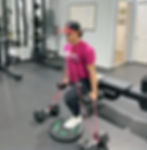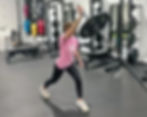Unleash Your Athletic Potential: The Importance of Training Staggered Stance
By: Mitch Kramer & Brandon Hogan
In the world of athletic performance, every edge counts. From the swift movements of a sprinter to the explosive power of a basketball player, the body's ability to generate force efficiently can make all the difference. One often-overlooked aspect of this efficiency is the training of the staggered stance.

The staggered position is when one foot or leg is positioned ahead of the other allowing us to move more efficiently and faster in every direction. Improving an athlete’s performance accounts for all modes of movement so they are prepared for anything come game time. To accomplish this we use reaction drills, strength, plyometrics, and agility drills.
Why is Training Staggered Stance Crucial for Athletic Performance:
Majority of sports will involve movements where the body is in a staggered or two-point stance. Training the body’s muscles to react quickly and strongly through a staggered stance sets the athlete up to better position themselves to perform specific movements to stay ahead of the competition. Increasing strength improves the muscles' abilities to contract and move the body, plyometrics improve overall explosiveness, and reaction and agility drills improve the body’s positioning and quickness of muscle activity prompted by a cue.
Enhanced Stability and Balance: The staggered stance challenges the body to stabilize itself in a less conventional position, improving overall balance.. By training in this stance, athletes develop a solid foundation from which to generate power and react swiftly.
Improved Coordination and Agility: Adopting a staggered stance requires coordinated movement between the upper and lower body. This not only enhances agility but also improves the ability to transition between different athletic movements, whether it's changing directions or exploding into a jump.
Optimized Force Production: Staggered stance training encourages athletes to engage multiple muscle groups at the same time, leading to more efficient force production. This translates to greater power output during explosive movements such as jumps, sprints, and throws.
Injury Prevention: A strong, stable stance is a great defense against injuries. By training in staggered positions, athletes strengthen supporting muscles and ligaments, reducing the risk of strains, sprains, and other common athletic injuries.
Sport-Specific Application: Many sports require athletes to perform in staggered stances naturally. By working these positions through specific training, athletes can directly translate their skills to their chosen sport, gaining a competitive edge on the field, court, or track.
Functional Movement Patterns: Staggered stance training mimics real-world movement patterns, making it highly applicable to everyday activities as well. Whether it's lifting groceries or climbing stairs, the stability and balance gained from this training can enhance overall functional fitness.

How to Program Staggered Stance Exercises Into Your Training
Incorporating staggered stance exercises into your training routine can be both straightforward and highly effective. Whether you're a seasoned athlete or just starting on your fitness journey, here's how to program these exercises for maximum benefit:
Start with Stability: Begin with basic stability exercises to familiarize yourself with the staggered stance position. This could include static holds such as split stance holds or dynamic stability exercises like staggered stance medicine ball tosses.
Progress with Resistance: Once you've established stability, gradually introduce resistance to challenge your muscles further. Incorporate exercises such as weighted split squats, Bulgarian split squats, trap bar deadlifts, or single-leg Romanian deadlifts into your routine. Start with lighter weights and focus on perfecting your form before increasing the load.
Vary Repetition Ranges: To promote muscle growth and strength development, vary your repetition ranges. Include both higher-rep sets (10-15 reps) for muscular endurance and lower-rep sets (4-8 reps) for strength and power. Experiment with different tempos, such as slow eccentric phases or explosive concentric movements, to further challenge your muscles.
Performance with Plyometrics: Add in staggered stance plyometric exercises such as broad jumps, box jumps, and single-leg hops into your training regimen to enhance power and explosiveness from that stance. Plyometrics can improve reactive strength and the ability to generate force rapidly, translating to greater athletic performance on the field or court.
Integrate Functional Movements: As you progress, incorporate staggered stance exercises that mimic the movements of your chosen sport or activity. For example, basketball players may benefit from staggered stance lateral lunges to improve lateral quickness, while runners might incorporate staggered stance split jumps to enhance explosive power.
Pay Attention to Recovery: Staggered stance exercises can be demanding on the muscles and joints, so prioritize recovery and proper rest between sessions. Incorporate rest days into your training schedule and complement your workouts with adequate nutrition, hydration, and sleep to support muscle repair and growth.
Listen to Your Body: As with any training program, listen to your body and adjust the intensity and volume of staggered stance exercises accordingly. If you experience pain or discomfort, reassess your technique, reduce the load, or consult with a qualified fitness professional to prevent injury.
By strategically programming staggered stance exercises into your training regimen, you can enhance stability, strength, and athleticism, ultimately unlocking your full potential as an athlete.
Now Take Action and Let The Gains Begin
Ultimately, mastering the staggered stance is about unlocking your body's full potential. By embracing this foundational element of athletic performance, athletes can elevate their skills to new heights, achieving greater speed, power, and agility on their journey to success. So, take a step forward—literally—and discover the transformative power of training in staggered stance.
